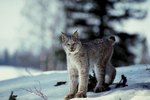
Along with the panther, the wild bobcat is one of two predatory big cats native to the Florida region. The bobcat is more common and much smaller than the panther, which is rarely sighted in the wild. Bobcats are found throughout the state from the deepest swamps to suburban backyards. The bobcat is one of several wild creatures that still call Florida home.
Name & Appearance
The Florida wild bobcat, or Felidae rufus Floridanus, is immediately identifiable by its short tail (or bob) and the fringes of fur that outline the sides of its head. It weighs between 13 and 30 pounds and has a tail with white on its underside and black markings on its top side. The Florida bobcat has spots of white fur on all parts of its fur, which can range in color from reddish-brown to grey. The adult bobcat can grow to about 50 inches in length and stands 21 inches tall on average. With a maximum adult weight of 35 pounds, the bobcat is similar in size to a young Florida panther for which it is sometimes mistaken.
Lifespan & Location
The wild bobcat is found in wildernesses everywhere from Canada to Central America, but the Florida bobcat is present even in the most densely populated areas. The female bobcat needs about 5 square miles of range while the male requires 15-30. The bobcat's range may consist in part of both wilderness and developed areas, and will include enough unpopulated land for a den and sufficient food supplies. The bobcat lives for a period of up to 14 years in the wild and can coexist with the panther, as the two do not share prey. The Florida bobcat lives in a den that consists of a hollow tree, cave, rock outcropping or other open shelter.
Prey and Predators
Bobcats are somewhat opportunistic in what they eat, which varies from small rodents and birds to carrion. Bobcats are mainly nocturnal hunters who may also prey during the daylight hours if necessary. During the summer the Florida, bobcats will eat mostly local fauna including squirrels, opossums, rabbits and raccoons. During the winter months, they shift attention to the many species of migrating birds that pass through Florida to escape the cold climates to the north.
Mating & Offspring
The male Florida bobcat has a range that touches the range of several females with whom he mates. The Florida bobcat has a litter of one or two kittens after a gestation period of 50 to 60 days. The mating season runs from August to March when food is most plentiful, and babies are born in the early spring. A single male may sire several litters at one time.
Additional Facts
Bobcats may have more than one home, with spare dens spread around the range in case of need. The Florida bobcat is seen in all types of habitats including suburban yards, and even city streets from time to time. Bobcats typically do not approach humans but will do so if fed or taught to associate people with access to food. Bobcats can swim and climb trees with ease, two factors that prevent them from falling prey to natural enemies besides human hunters. The Florida bobcat is not endangered.
References
- Big Cat Rescue: Bobcat Facts
- Felid: Bobcats in Florida
- Florida Fish and Wildlife Conservation Commission: Bobcat: Lynx rufus
- University of Florida: Florida's Large Carnivores
- Wild Cat Sanctuary: Spectacular Photos of a Bobcat in the Wild
- Defenders of Wildlife: Basic Facts About Bobcats
- News Channel 5: Bobcat Roams Suburban Boynton Beach Neighborhood
- Ventura County Animal Services: Bobcats
Photo Credits
-
Tom Brakefield/Stockbyte/Getty Images
Writer Bio
Robert Morello has an extensive travel, marketing and business background. He graduated with a Bachelor of Arts from Columbia University in 2002 and has worked in travel as a guide, corporate senior marketing and product manager and travel consultant/expert. Morello is a professional writer and adjunct professor of travel and tourism.



